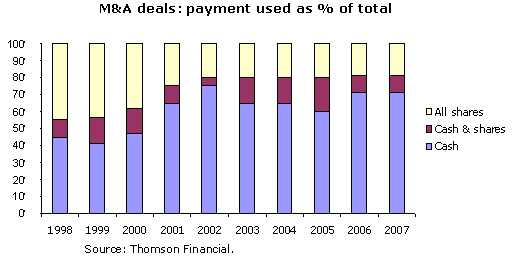The 2008 EBIT multiple can be calculated on the basis of the present value (ie, in 2007) of capital employed divided by the estimated 2008 EBIT (1). Alternatively, the 2008 EBIT multiple can be calculated on the basis, not of the present value of capital employed, but on the 2008 value of capital employed divided by 2008 EBIT. In order to do this, you have to estimate the value of 2008 capital employed which is then calculated as the sum of the (2008) market capitalisation and estimated net debt for 2008.
The advantage of this method is that it factors in the company's investment policy, since it would appear illogical to take into account, for 2008 EBIT, the contribution to 2008 EBIT by investments made in 2007 and 2008, without taking into account the financing put in place (debt or equity) for making these investments. It makes it possible to differentiate the multiples of companies with different growth and investment profiles.
Although in theory this is a very laudable goal, the implementation in practice is rather more disappointing:
• Conceptually, no valid explanation can be offered for using the 2007 market capitalisation instead of the 2008 market capitalisation to calculate the value of 2008 capital employed, when 2008 debt is deducted. However, in practice, only the net value of 2008 debt is estimated. Of course, you’d have to be quite clever to forecast in 2007 what the 2008 market capitalisation will be. The 2008 market capitalisation could be estimated by capitalising the value of 2007 equity at the cost of equity, less the yield. This is, however, very rarely done. The 2008 multiple for 2008 EBIT depends on the company’s financing policy since the more debt was used to finance 2007-2008 investments, the higher the multiple will be. This is an aberration.
• Those who are used to reading financial analysts' notes know that it is relatively rare to find projections on how the value of capital employed will be adjusted to the value of equity, beyond debt: even though projections on reserves, pension fund provisions, minority interests, financial assets and companies accounted for under the equity method are required. These items are usually considered as constant, given the difficulties involved in forecasting them.
This approach for calculating multiples seems to us, all things considered, to be less relevant than the “fixed” approach (2007 capital employed divided by the 2007, 2008, 2009… aggregate to obtain the 2007, 2008, 2009… multiple). There is also the risk that it will turn valuers into a remorseless calculators, when first and foremost, they should be people who have the ability to reflect.

